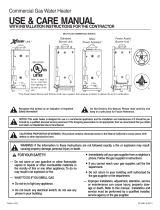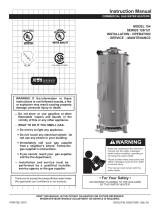
6
INSTALLATION
Locating the Water Heater
This water heater MUST be installed indoors out of the wind and weather.
This water heater must NOT be installed in any location where gasoline or
flammable vapors are likely to be present, unless the installation is such
to eliminate the probable ignition of gasoline or flammable vapors.
The location of this water heater is of the utmost importance. Before installing
this water heater, you must read the Installation section of these instructions.
After reading these Installation and Operating Instructions, select a location for
the water heater where the floor is level and is easily accessible to water lines,
gas supply (type identified on the rating plate), an adequate open drain, and a
chimney or exhaust gas vent. DO NOT locate the water heater where water
lines could be subjected to freezing temperatures. Make sure the cold
water pipes are not located directly above the gas control so that
condensate during humid weather does not drip on the controls.
Adequate clearances must be provided for easy access to controls by service
personnel to enable proper cleaning, servicing, and operation of the water
heater. Under no circumstances is the front of the water heater to be placed in
a position where the burner tray assembly can not slide out for removal when
servicing.
Water heater corrosion and component failure can be caused by the heating
and breakdown of airborne chemical vapors. Examples of some typical
compounds that are potentially corrosive are: spray can propellants, cleaning
solvents, refrigerator and air conditioning refrigerants, swimming pool
chemicals, calcium and sodium chloride, waxes and process chemicals. These
materials are corrosive at very low concentration levels with little or no odor to
reveal their presence. NOTE: DAMAGE TO THE WATER HEATER CAUSED
BY EXPOSURE TO CORROSIVE VAPORS IS NOT COVERED BY THE
WARRANTY. DO NOT OPERATE THE WATER HEATER IF EXPOSURE
HAS OR WILL OCCUR. DO NOT STORE ANY POTENTIALLY CORROSIVE
COMPOUNDS IN THE VICINITY OF THE WATER HEATER.
WARNING
Water heaters are heat producing appliances. To avoid damage or
injury there must be no materials stored against the water heater and
proper care must be taken to avoid unnecessary contact (especially by
children) with the water heater components. UNDER NO
CIRCUMSTANCES MUST FLAMMABLE MATERIALS, SUCH AS
GASOLINE OR PAINT THINNER BE USED OR STORED IN THE
VICINITY OF THIS WATER HEATER, VENT-AIR INTAKE SYSTEM
OR IN ANY LOCATION FROM WHICH FUMES COULD REACH THE
WATER HEATER OR VENT-AIR INTAKE SYSTEM.





















